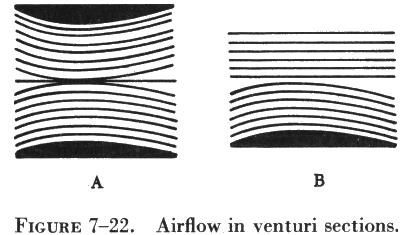
General
In the earlier discussion of fluids, Bernoulli's principle was introduced to explain the relationship between velocity and pressure of a liquid flowing through a venturi. Since Bernoulli's principle applies to fluids, which by definition include both gases and liquids, its application to gases (air) is included at this point to explain the relationship between air velocity and pressure on the surfaces of an airfoil.
How an Aircraft Wing Reacts with the Atmosphere
An airfoil is any surface designed to obtain a reaction from the air through which it moves. Wings, ailerons, elevators, stabilizers, propeller blades, and helicopter rotors are all airfoils.
The reaction for which wings are designed is called lift. A wing produces lift because of a pressure difference; and the greater this difference, the more lift developed. If the air pressure above a wing is the same as that below it, there is no lift. But if the pressure above a wing is reduced and the pressure below increased, then lift is produced. The strong air pressure below the wing moves the wing upward against the weaker pressure above the wing. But what causes these unequal pressures?
An examination of the shape of an aircraft wing discloses that it has been designed to create a pressure difference. If a wing is cut from leading edge to trailing edge, the end view of the cut is a profile section similar to the one shown in figure 7-21. The forward part of the airfoil profile is rounded and is called the leading edge. The aft part is narrow and tapered and is called the trailing edge. A reference line often used in discussing airfoils is the chord, an imaginary straight line joining the extremities of the leading and trailing edges. The curved upper surface of the airfoil is called the camber. The lower surface is normally straight, or only slightly curved.

An airfoil is very similar in shape to half a venturi section. In A of figure 7-22, the throat, or restricted portion of a venturi is illustrated. The airflow through the venturi is indicated by flow lines.
In B of figure 7-22, one-half of a venturi restriction is shown, together with the airflow over its curved surface. Note that this portion of a venturi has the same profile as that of an airfoil.

To understand how lift is produced by an aircraft's wings, Bernoulli's principle is applied to an airfoil. This principle reveals that the pressure of fluid (liquid or gas) decreases at points where the speed of the fluid increases. In other words, high speed is associated with low pressure, and low speed with high pressure. The wing, or airfoil, of an aircraft is designed to increase the velocity of the airflow above its surface, thereby decreasing pressure above the airfoil. Simultaneously, the impact of the air on the lower surface of the airfoil increases the pressure below. This combination of pressure decrease above the airfoil and increase below the airfoil produces lift.